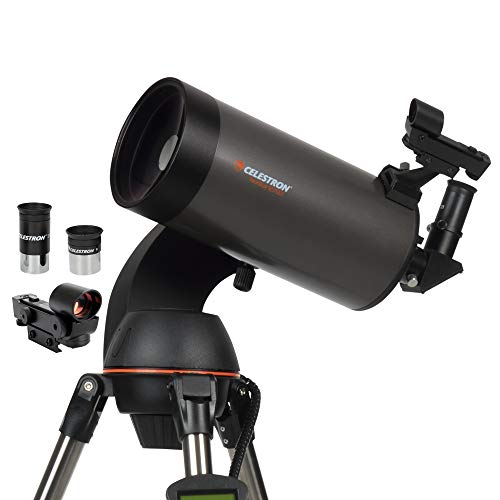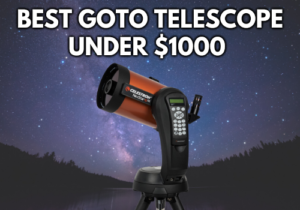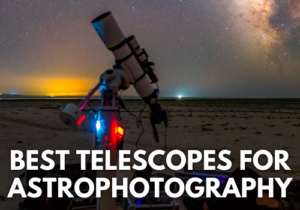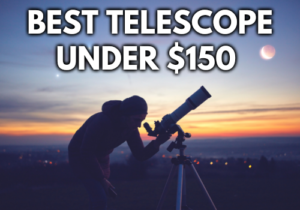Best Telescope For City Viewing (For Light Polluted Skies)
Disclosure: This post contains affiliate links and I may earn a small commission (at no extra cost to you) if you click through and make a purchase. Thanks in advance – I really appreciate it!
Stargazing in light-polluted city skies poses a different kind of challenge for an amateur astronomer. Light pollution around us in the cities is a side effect of industrial civilization.
People living in cities with high levels of sky glow have a hard time seeing more than a handful of stars at night. Astronomers are particularly concerned with sky glow pollution as it reduces their ability to view celestial objects.
But with the right telescope, light pollution can be tackled and you can get great views of the night sky from your city apartment or condo.
If you’re looking for a telescope for city viewing, we’ve put together this list of amazing products you’ll be sure to love.
Our Pick
Celestron – NexStar 8SE
- Nexstar computerized telescope: The NexStar 8SE Computerized Telescope features Celestron’s iconic orange tube design with updated technology and the latest features for amazing stargazing for beginners and experienced observers.
Prices pulled from the Amazon Product Advertising API on:
Product prices and availability are accurate as of the date/time indicated and are subject to change. Any price and availability information displayed on [relevant Amazon Site(s), as applicable] at the time of purchase will apply to the purchase of this product.
The Celestron NexStar 8SE 203mm f/10 Schmidt-Cassegrain GoTo Telescope is a powerful yet portable scope that can be used for observing everything from the Moon and planets to deep-sky objects like stars, galaxies, and nebulae, all from the comfort of your home. The telescope is perfectly suitable for an urban setting as the views are not going to be affected by light pollution. This Celestron’s computerized telescope yields super crisp images of the night sky and, once aligned, finds objects with dead-on accuracy.
Budget Pick
Celestron PowerSeeker 127 EQ
- Perfect entry-level telescope: The Celestron PowerSeeker 127EQ is an easy-to-use and powerful telescope. The PowerSeeker series is designed to give the new telescope user the perfect combination of quality, value, features, and power
Prices pulled from the Amazon Product Advertising API on:
Product prices and availability are accurate as of the date/time indicated and are subject to change. Any price and availability information displayed on [relevant Amazon Site(s), as applicable] at the time of purchase will apply to the purchase of this product.
Celestron’s PowerSeeker 127EQ 127mm f/8 Reflector Telescope is a great pocket-friendly option for near and deep-sky observation of celestial objects. Although the telescope is designed for portability and to take on a range of outdoor conditions, you can use it from your city apartment windows, balcony, or your terrace to get detailed images of the Moon, clear views of the planets, and resolve bright distant objects such as nebulae and galaxies.
Also Great
Orion StarBlast II 4.5 Reflector
- The whole family will enjoy the StarBlast II 4.5 EQ thanks to its great optics, convenient portability, and easy-to-use operation
- Views of everything from the Moon and planets to distant objects like star clusters and galaxies appear bright and clear through this petite telescope
Prices pulled from the Amazon Product Advertising API on:
Product prices and availability are accurate as of the date/time indicated and are subject to change. Any price and availability information displayed on [relevant Amazon Site(s), as applicable] at the time of purchase will apply to the purchase of this product.
The Orion StarBlast II 4.5 is one of the most affordable reflector telescopes on the market, this fast f/4.0 telescope is an ideal option for beginner and intermediate city-dwellers alike. It makes locating celestial objects from your windows or building terraces easy, moreover the optical components are high-quality at a low price.
Telescopes We Recommend For City Viewing
| Image | Title | Price | Prime | Buy |
|---|---|---|---|---|
 Top
Top | Celestron - PowerSeeker 127EQ Telescope | PrimeEligible | See on Amazon | |
 Top
Top | Celestron - NexStar 8SE Telescope | PrimeEligible | See on Amazon | |
 Top
Top | Orion StarBlast II 4.5 Equatorial Reflector Telescope | Prime | See on Amazon | |
 Top
Top | Orion 09007 SpaceProbe 130ST Reflector | Prime | See on Amazon | |
 Top
Top | Celestron - NexStar 127SLT Computerized Telescope | PrimeEligible | See on Amazon | |
 Top
Top | Orion 10012 SkyScanner 100mm | Prime | See on Amazon | |
 Top
Top | Gskyer AZ90600 Telescope | PrimeEligible | See on Amazon |
Product prices and availability are accurate as of the date/time indicated and are subject to change. Any price and availability information displayed on [relevant Amazon Site(s), as applicable] at the time of purchase will apply to the purchase of this product.
Prices pulled from the Amazon Product Advertising API on:Best Telescope For City Viewing In Light Polluted Skies
1. Celestron PowerSeeker 127 EQ
- Perfect entry-level telescope: The Celestron PowerSeeker 127EQ is an easy-to-use and powerful telescope. The PowerSeeker series is designed to give the new telescope user the perfect combination of quality, value, features, and power
Prices pulled from the Amazon Product Advertising API on:
Product prices and availability are accurate as of the date/time indicated and are subject to change. Any price and availability information displayed on [relevant Amazon Site(s), as applicable] at the time of purchase will apply to the purchase of this product.
The Celestron PowerSeeker 127 EQ telescope kit is the best-selling telescope model in the country. Beginners love it because it is affordable and super easy to set up and use. No tools are required for its assembly which just involves attaching the telescope tube to a preassembled tripod and equatorial mount. Intermediates and professionals love it because of its great optics.
The telescope comes with two eyepieces (20 mm and 4 mm), a 3x Barlow lens to increase your magnifying power, and Celestron’s very own astronomy software called “Starry Night.”
The Celestron PowerSeeker 127 EQ Telescope has a manual equatorial mount that features slow-motion control cables with large knobs to make it easy to track objects, while also minimizing vibrations caused by handling the mount with your hands.
You can easily set the telescope’s height according to your city apartment windows or balcony as it also comes with an adjustable-height aluminum tripod with a tray for accessories such as eyepieces, filters, and lights.
If you live in a city and are brand new to the hobby, have never seen the rings of Saturn, Moons of Jupiter, or a close-up lunar crater before, and don’t have few extra hundreds of dollars lying around to test whether astronomy is the hobby for you, then this telescope is a great way of finding out.
2. Celestron – NexStar 8SE
- Nexstar computerized telescope: The NexStar 8SE Computerized Telescope features Celestron’s iconic orange tube design with updated technology and the latest features for amazing stargazing for beginners and experienced observers.
Prices pulled from the Amazon Product Advertising API on:
Product prices and availability are accurate as of the date/time indicated and are subject to change. Any price and availability information displayed on [relevant Amazon Site(s), as applicable] at the time of purchase will apply to the purchase of this product.
With Celestron’s NexStar 8SE computerized telescope you not only get the large aperture for a better light grasp on faint DSOs, but you’ll also have the GoTo capability to track objects and learn a thing or two about astrophotography. The views you see at the eyepiece will take your breath away if you’ve never used a scope before, or even if you’re used to something smaller.
The telescope has an excellent 8-inch aperture with good light-gathering power that will provide impressive views from the Moon, planets, and deep-sky objects while keeping and compact form factor. Moreover, the optical tube is surprisingly light making it is easy to assemble.
The NexStar 8SE GoTo Telescope comes with a computer packed with a database of more than 40 000 objects to select from a menu and the telescope will automatically point to it.
When it finishes tracking look through the eyepiece and that’s it. You will operate everything through the NexStar Keypad Control.
The big aperture on the Celestron NexStar 8SE will show dimmer objects like galaxies and nebulae in detail even if the city sky is light-polluted. With its ability to deliver high magnification, it’s ideal for seeing the Moon and observing the planets. You can comfortably push it beyond 200x magnification for bright objects.
A StarPointer red-dot finder, E-Lux 25mm, 1.25-inch fit Plössl eyepiece, and a star diagonal complete the optical tube assembly.
The mount is a single-arm, all-in-one unit with the neatly integrated NexStar hand controller, which can be pulled out when in use.
There is a power connector and switch on the outside base of the arm, and a battery compartment for eight AA batteries on the top of the base, along with aux ports.
3. Orion StarBlast II 4.5 Reflector Telescope
- The whole family will enjoy the StarBlast II 4.5 EQ thanks to its great optics, convenient portability, and easy-to-use operation
- Views of everything from the Moon and planets to distant objects like star clusters and galaxies appear bright and clear through this petite telescope
Prices pulled from the Amazon Product Advertising API on:
Product prices and availability are accurate as of the date/time indicated and are subject to change. Any price and availability information displayed on [relevant Amazon Site(s), as applicable] at the time of purchase will apply to the purchase of this product.
The compact Orion StarBlast II 4.5 EQ is a great choice for both beginners and expert astronomers alike, and stargazers won’t outgrow the telescope thanks to its great optics, convenient portability, and easy-to-use operation.
This scope features a reasonably large 4.5” aperture that draws in enough light for you to enjoy many showpiece objects in the sky. The large aperture combined with the short focal length makes for a fast telescope.
This generally means lower magnifications and larger fields of view. The images you see will also be brighter than in a longer focal length scope of the same aperture.
The StarBlast II EQ comes with two eyepieces: A 25mm Sirius Plossl (18x) and a 10mm Sirius Plossl (45x). The telescope also comes with a red dot finder and a moon map that you can use while looking at the moon from your city apartment balcony.
With the StarBlast II’s high-quality optics you can see Mercury and Venus’ phases, along with the dark albedo patches and ice caps on Mars. You can also see Jupiter’s cloud belts, the Great Red Spot, and its 4 large moons. If there isn’t much light pollution around and the air is stable, you can also see the two gas giants – Neptune and Uranus with this affordable telescope for city viewing.
The EQ-1 mount supplied with this telescope is a pared-down version of the large and expensive German EQ mounts popular for large scopes and astrophotography.
The mount is easy to set up and maneuver. All you’ll need to do is level the tripod, attach the optical tube, and align the polar axis of the mount with Polaris.
4. Orion 09007 SpaceProbe 130ST
- This 5.1 inch aperture reflector telescope gathers an ample amount of light for great views of the planets and Moon, as well as brighter galaxies, nebulas, and star clusters
- Short 24 inch long optical tube design for easy portability and fast f/5 focal ratio for pleasing wide-field performance makes the SpaceProbe 130ST EQ a very versatile telescope the whole family can enjoy
Prices pulled from the Amazon Product Advertising API on:
Product prices and availability are accurate as of the date/time indicated and are subject to change. Any price and availability information displayed on [relevant Amazon Site(s), as applicable] at the time of purchase will apply to the purchase of this product.
The Orion SpaceProbe 130ST Newtonian Reflector is an excellent telescope. It is well-suited for beginners or intermediate users who are looking for a telescope that can mitigate the effects that light pollution can have on stargazing.
It’s an excellent reflector telescope with a large 5.1” aperture. And as we know, the bigger the scope, the more light can get in. With a large aperture and a fast f/5 focal ratio, you’ll have a nice wide field of view for stargazing and seeking out nebulae and other DSOs. Its primary mirror is parabolic, so there will be little to no noticeable aberration.
Its primary mirror allows great views of the planets and moon, and its wide field of view is great for bright nebulas, galaxies, and star clusters.
The telescope comes with two Sirius Plossl eyepieces. At 25mm and 10mm, they offer magnifications of 26x and 65x respectively.
The Orion 09007 SpaceProbe’s sturdy EQ-2 equatorial telescope mount and adjustable tripod allows manual slow-motion tracking of celestial objects as they appear to migrate across the night sky.
The adjustable-height aluminum tripod is strong yet lightweight and includes an accessory tray so you can keep eyepieces, flashlights, and other accessories close by while using the reflector telescope.
A 6×30 achromatic finder is also included and it does a decent job of revealing more stars in the sky than your naked eye.
If you want to take pictures of the night sky, the SpaceProbe can handle webcam-style cameras and possibly smartphones with an adapter.
The telescope also comes with a 1.25inch rack and pinion focuser, tripod accessory tray, collimation cap, Starry Night astronomy software along with a set of other documents including the assembly instructions.
5. Celestron – NexStar 127SLT
- Computerized star locating telescope: The Celestron NexStar 127SLT is a computerized telescope that offers a database of more than 40,000 stars, galaxies, nebulae, and more. The telescope locates your object with pinpoint accuracy and tracks it.
Prices pulled from the Amazon Product Advertising API on:
Product prices and availability are accurate as of the date/time indicated and are subject to change. Any price and availability information displayed on [relevant Amazon Site(s), as applicable] at the time of purchase will apply to the purchase of this product.
If you’re looking for an affordable telescope to view the solar system and bright deep-sky targets, then the NexStar 127 SLT is a great option. At a moderate price and with a decent-sized aperture of 5 inches, this GoTo Maksutov-Cassegrain telescope is a worthy contender for those urban astronomers looking for great views of the city skies along with their friends & family.
In terms of computerized telescopes, the CelestronNexStar 127SLT is on the lower end in terms of price, works as intended, and comes with a reliable Maksutov-Cassegrain optical setup that eliminates common issues found in refractors and reflectors by taking the best of both and combining them.
Celestron NexStar 127 SLT easily gathers detail from Jupiter. Galilean moons, The Great Red Spot, and the storm clouds are colorful and clear.
Saturn shows its rings with the Cassini Division in the middle. On a good steady night, you can get images of its moons too.
Phases of Venus are observable, and the planet itself looks like a bright, yellow disk.
The Celestron NexStar 127 SLT tube is made of a high-quality aluminum build with no sign of flimsy plastic features.
The NexStar SLT’s hand controller offers a database of about 4,000 objects. The telescope comes with two 9 mm and 25 mm Plössl eyepieces, which provide magnifications of 167x and 60x.
6. Orion 10012 SkyScanner 100mm
- An ideal entry-level reflector telescope with 100mm parabolic primary mirror optics - no plastic lenses as found in some other telescopes made for beginners
- See hundreds of craters on the Moon, detail on Jupiter and other planets, even when viewing from relatively bright city locations
Prices pulled from the Amazon Product Advertising API on:
Product prices and availability are accurate as of the date/time indicated and are subject to change. Any price and availability information displayed on [relevant Amazon Site(s), as applicable] at the time of purchase will apply to the purchase of this product.
The Orion SkyScanner 100 is a compact Newtonian reflector telescope with a 100 mm aperture. It has a 400 mm focal length for a focal ratio of F4. Being small and light it is a real “grab n’ go” telescope.
Included with the SkyScanner are two eyepieces: 20 mm and 10 mm and they provide 20x and 40x magnification.
They’re Kellner eyepieces and they work well with this telescope. They’re especially good with low to medium magnifications, but a Barlow lens will help take advantage of maximum power for planetary observation.
With the stock eyepieces and a 3x Barlow, you’ll be able to explore quite a lot including globular clusters and our planets with some of their features, but max useful magnification will top out at about 150x due to the inability to focus precisely at such high power.
The Orion SkyScanner is a great performer for bright DSOs and good lunar and planetary observation.
You can use this telescope to view Jupiter, its red spot, and even its cloud bands with solid detail near the maximum magnification.
You can also see Saturn’s rings and the color of the planet, Mars, and some of its surface details at the max magnification.
Uranus and Neptune, because of their incredible distance from Earth, will appear as blue disc-like shapes without any details through this telescope.
Orion SkyScanner 100 comes already assembled and mounted on the base. The only assembly required is the attachment of the finder.
The included mount is a tabletop Dobsonian-style mount. All you have to do is place the telescope on a table, stool, or some other suitable stand so it is at a comfortable height. It is light enough that even a sturdy box could serve as a base.
7. Gskyer AZ90600 Telescope
- 【High Quality Optics】600mm(f/6.7) focal length and 90mm aperture, fully coated optics glass lens with high transmission coatings creates stunning images and protect your eyes
- 【High Magnification】Come with three replaceable eyepieces(24X, 60X,120X) and one 3x Barlow lens. 3x Barlow lens trebles the magnifying power of each eyepiece
Prices pulled from the Amazon Product Advertising API on:
Product prices and availability are accurate as of the date/time indicated and are subject to change. Any price and availability information displayed on [relevant Amazon Site(s), as applicable] at the time of purchase will apply to the purchase of this product.
The Gskyer 600x90mm AZ Telescope is one of the high-end beginner telescopes, offering great optical power and a couple of extras such as an image erect prism for ease of use.
The optical tube of this telescope features an aluminum alloy, making it highly durable. The telescope is easy to use thanks to the tube ring that enhances mounting.
An altazimuth mount and a stainless steel tripod make it comfortable to use while enhancing focus.
It comes with three replaceable eyepieces that enhance the power of the lens. That is why it creates focused images of divine celestial objects. You can use the telescope to watch celestial and terrestrial objects.
The Barlow lens that comes with the telescope boosts the magnification of the telescope and brings the faraway objects near you. That is why the images and videos are detailed. The aluminum tripod is adjustable with a moveable mount.
You can adjust the mount of the telescope according to your city apartment’s balcony or window height. The telescope is easy to assemble, and you do not need any high-quality mechanical tools.
The small finder scope that comes with it is actually really impressive – you can attach the finder to the main telescope very easily, and this will allow you to find whatever planet or object you want to before looking at it in closer detail through the main telescope.
With this one of the best telescopes for city viewing, you’ll easily be able to see all the major planets & much more without much aberrations. It’s a really good telescope for establishing wide-angle views with fast optics ideal for some nighttime astrophotography.
Tips For Using A Telescope For City Viewing
- A large aperture instrument will collect more starlight than a small aperture regardless of the ambient light conditions so it will pay to buy the largest aperture that you can afford.
- If you can afford it, then buy a computerized telescope as the light pollution around you in the city will make it more difficult to select suitable stars for manual star hopping to celestial objects.
- Add an extended light shield to the front of the telescope. This will not only reduce the risk of dew but would also help to reduce the interference from local light sources.
- If you’re taking pictures of the celestial objects with light pollution around you then you can make use of special light pollution suppression filters to remove some pollution effects during post-processing.
- You can use a good ultra-high contrast (UHC) filter. However, no filter will brighten a celestial object, all the filters can do is help to remove the unwanted light.
Written by:

Chandrashekhara Rao
I grew up in a rural community with a dark sky, and that is where I learned to appreciate planets and stars at an early age. I have been fascinated with all things astronomical since I was a kid and started with a cheap-and-cheerful 60mm refractor on a wobbly tripod.
ABOUT US
We are a team of active amateur astronomers, here to help you with all your astronomy and science related needs – this is anything, from reviewing the latest telescopes to be released to talking about gravity and neurons. The Big Bang Optics was started because of our love for astronomy and to help others like us find the best telescope and accessories.
LEGAL DISCLAIMER
The Big Bang Optics is a participant in the Amazon Services LLC Associates Program, an affiliate advertising program designed to provide a means for sites to earn advertising fees by advertising and linking to Amazon.com. The Big Bang Optics also participates in affiliate programs with Clickbank and other sites. The Big Bang Optics is compensated for referring traffic and business to these companies.











